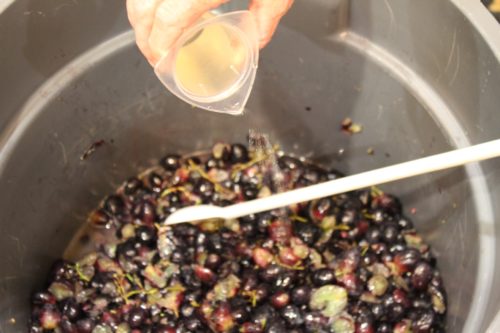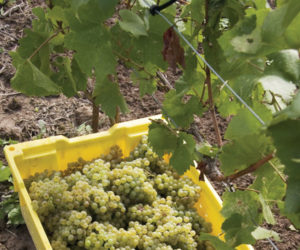
Some of the most common enzymes used in winemaking are maceration enzymes. In essence, these help break down grapes for a variety of goals like speeding up extraction, increasing juice yield, and increasing filterability. There are a variety of different products on the market, each with differing actions. Though in many cases these products are the most useful for large commercial wineries, there are applications where they are useful for the home winemaker. Let’s look at what enzymes are, the types of products that are out there, how they work, and when we may want to use them. We’ll also look at a couple of winemaking enzymes that aren’t “maceration enzymes” per se, but are useful to home winemakers, one of which is often sold blended with maceration enzymes.
Enzymes are an immensely diverse group of compounds, mostly proteins, which speed up one chemical process or another. All living organisms contain and rely upon enzymes; without enzymes, life as we know it would not be possible. Most enological enzymes are made using various fungal genera, usually from Aspergillus niger and Trichoderma species.
Most maceration enzymes are mixes (or “cocktails”) of pectolytic enzymes, some contain deactivated yeasts or other types of enzymes, each serving a different purpose. Pectins are a group of polysaccharides that form and hold together parts of plant cells. Pectolytic enzymes are various enzymes that break down pectins in different ways and at different points in their structure, sort of working as a team with one another. Examples are pectin lyase, polygalacturonase, and pectin methyl esterase. Part of the reason they’re sold in (and marketed as) “cocktails” is that production isn’t precise and the fungi that produce them produce various enzymes at the same time — i.e. they’re inherently produced in a blended form.
Grapes have naturally occurring enzymes, though in low concentrations, and low efficacy at wine pHs or in the presence of sulfur dioxide (SO₂). During maceration, without the addition of commercial enzymes, pectins do break down, but the use of commercial enzymes greatly speeds up the process and facilitates extraction of tannin, color, aroma precursors, and so on. This is especially useful for large commercial wineries, where more grapes may be coming in than they have fermenters to handle: Enzymes can turn a two-week maceration into a four-day maceration (to be pressed sweet) with similar results, freeing up fermenters much faster for the next pick. When space and time is not a concern, as for most home and small-scale wineries, this may be less critical, as most of these compounds will extract during normal maceration times, but may be useful if your fermentations usually run warm and fast and you want to maximize extraction.
Some enzymes claim to release more color in red macerations than would otherwise be released. Having more color available to tannins (in the form of monomeric anthocyanins) should shorten tannin polymer length, which should result in increased softness, stability, and wine-longevity (though in more structured wines, this may mean a wine needs more time before it’s ready to drink). More color can also be extracted by using quality, untoasted oak chips during maceration or by cofermenting with highly colored grapes or white grape skins, which you can use after pressing your whites. Although using color products like Mega Purple concentrate gives wines color in the visual sense, the color molecules aren’t monomeric, so cannot bind with tannins, and thus do not affect mouthfeel or longevity.
Though in many cases these products are the most useful for large commercial wineries, there are applications where they are useful for the home winemaker.
Maceration enzymes can be used for white wines as well. Pulpy (pectin-rich) white grapes, such as Albariño, may not yield as much juice when pressed whole cluster. Traditionally, such grapes may be macerated for hours to a couple of days to allow pectins to break down, increasing juice yield (and aroma precursor concentrations) at pressing. However, such practices aren’t without risk, as many spoilage bacteria love sugar. Also, unless you’re able to keep the maceration cold, fermentation can start. This isn’t inherently a bad thing (and many winemakers actually like to start white fermentations on the skins), but may increase or change fruit character and can lead to perceptible tannins. Enzymes can be utilized with these pulpy whites to quickly break grapes down and boost juice yield at pressing, minimizing time exposed to such risks.
Maceration enzymes also boost yields when settling wines. After pressing, most winemakers let wine settle overnight to allow grape solids to settle to the bottom of the tank. Pectolytic enzymes speed up this process and give a better sedimentation, so you lose less wine when racking off the next day. This can mean as much as a 15% yield increase for reds and a 7% increase for whites: Even if you’re only making a carboy or two, particularly for reds, that’s another couple bottles. Most home winemakers probably aren’t filtering must (cleaner white must leads to increased levels of fruity esters), but this better sedimentation makes must filtration much easier and makes filter cartridges last longer.
If you like to harvest reds especially ripe and water back your must, using maceration enzymes can give you a quicker, more accurate sugar reading, allowing for more precision when watering back to your desired Brix level. Add the enzymes at crush and measure the next day — the quicker breakdown of grapes means a quicker release of sugar and therefore a shorter time to wait for an accurate measurement.
There are a multitude of different maceration enzyme products on the market. As with any enological product, I recommend you contact the company and chat with them to figure out which product is the best for your goals and the specific wine you are working with. There are a few things to consider when purchasing enzymes beyond its actions. Liquid enzymes, though easier to use (they’re ready to go out of the bottle, no rehydrating), have a shorter shelf life and must be stored cold. Powdered enzymes, once rehydrated, should be used within a few hours. Although it’s now uncommon, be sure your enzyme cocktail does not contain cinnamoyl esterase, which with certain yeast strains can result in off-odors.
Although they aren’t maceration enzymes, I’d like to mention two other winemaking enzymes, which would complete the range of common winemaking enzymes: Beta-glucosidase and lysozyme. Beta-glucosidase (often written as β-glucosidase) is an enzyme that liberates aroma precursor compounds from glucose molecules. Specifically, it liberates isoprenoids (often called “terpenes”) and norisoprenoids. These can run the gamut from floral to fruity to the classic petrol aromas of Riesling — they’re very large and diverse groups of aromas, and, of course, vary in every batch of grapes depending on variety, site, and vintage. Generally, these are used with “aromatic” varieties — usually whites — like Muscat or Viognier, to maximize the intensity of aromatics. Beta-glucosidase is also commonly included in “cocktails” with pectolytic enzymes, especially those intended for aromatic whites.
Some yeast strains naturally produce high levels of beta-glucosidase, and inherently have this action. QA23 is a well-known example. A study (https://www.sciencedirect.com/science/article/pii/S1756464615004582) found that yeasts that produce high levels of beta-glucosidase also release much more resveratrol in grapes — a compound being studied for heart health and increasing life- and health-span. As exciting as that sounds, unfortunately resveratrol levels in wine are still much, much too low to have any significant impact in these areas (despite what some successful marketing campaigns would like us to believe).
Lysozyme is a unique wine enzyme. Whereas all the enzymes we’ve discussed so far are produced (commercially) by various fungi, lysozyme is extracted from egg whites; it’s also found in milk, human tears, and many other places in nature. Rather than helping with extraction or breaking things down in wine, it’s more simply an antimicrobial agent, especially against gram-positive bacteria like malolactic bacteria (Oenococcus), and other potentially problematic lactic acid bacteria. It’s an especially handy enzyme for home winemakers who want to make crisp whites by blocking malolactic fermentation, but don’t have the ability to sterile filter. Using lysozyme kills bacteria (via “lysis”) by breaking down their membrane.
To apply any enzyme product, it’s best to always run bench trials to determine dose. High alcohol content and cold temperatures reduce enzyme efficacy and may require a higher dose. Keep in mind that temperatures of 40 °F (4 °C) or below, or alcohol levels above 17%, may stop enzymes from working. Enzyme sensitivity to SO₂ should be considered, but is in all likelihood not a concern. For example, Enartis’ Zym RS works normally even with 2,000 ppm of SO₂ — that’s more than 10 times what most winemakers will ever use in a given wine. That said, don’t add SO₂ and enzymes at the same time, it’s best to wait until one has been well mixed into your must.
For the most part, I think that enzymes are most useful for larger commercial wineries, in that they speed up macerations to free up tank space, save money on filter pads and electricity use in certain areas, and so on. Other than increasing juice/wine yield, most of the goals of enzymes can be obtained with normal or careful winemaking practices. For example, keeping a red ferment cool enough to give a two- to three-week maceration during the fermentation will likely lead to similar results as with an enzyme addition. With pulpy or aromatic whites, a careful cold soak (perhaps with the help of a small glycol chiller and a cooling plate) will allow pectins to break down naturally prior to pressing, increasing juice yield and aroma precursor concentrations, and avoiding the need for enzymes. That said, enzymes can make our lives much easier and help us craft the wines we want to make.






